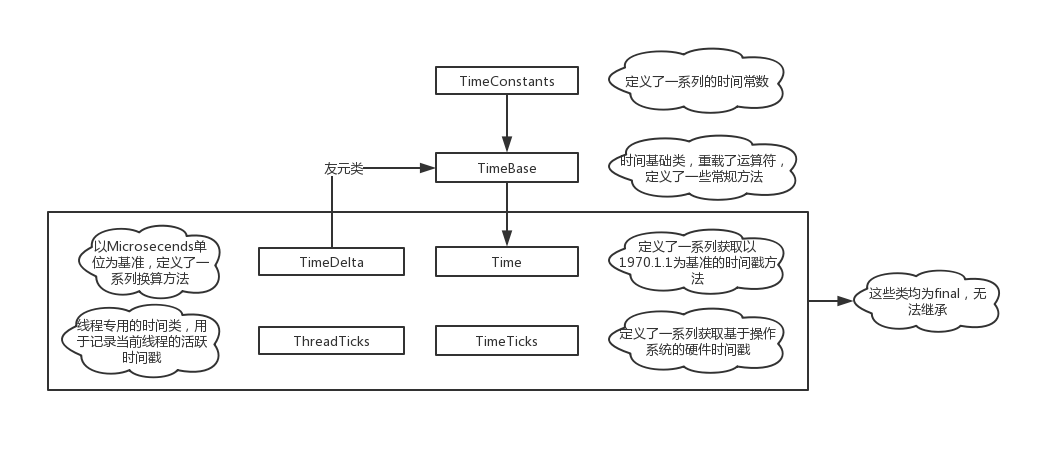积跬步,行千里,先从最简单的开始写。
这一篇介绍V8中的时间模块,与libuv粗糙的update_loop_time方法不同,V8有一套独立完整的类负责管理时间。
该类位于src/base/platform/time.h,是一个辅助模块,首先来看一下继承树。

整个模块的继承关系比较简单,一般常用的就是Time、TimeTicks类,这里挨个进行介绍吧。
TimeConstants
这个类很直接,只是定义一些常量,比如一星期有7天,一天有24小时,一小时有60分钟等等……
class TimeConstants { public: static constexpr int64_t kHoursPerDay = 24; static constexpr int64_t kMillisecondsPerSecond = 1000; static constexpr int64_t kMillisecondsPerDay = kMillisecondsPerSecond * 60 * 60 * kHoursPerDay; // ... };
TimeDelta
这个类提供把各种单位的时间转换为microseconds的方法。

class V8_BASE_EXPORT TimeDelta final { public: constexpr TimeDelta() : delta_(0) {} // Converts units of time to TimeDeltas. static constexpr TimeDelta FromDays(int days) { return TimeDelta(days * TimeConstants::kMicrosecondsPerDay); } // ... }
这里的常数定义来源于上面的TimeConstants类。
TimeBase
这个类没啥好说的,比较特殊的地方就是这是个模版类,提供对给定类型的时间序列化功能。
template <class TimeClass> class TimeBase : public TimeConstants { public: // ... int64_t ToInternalValue() const { return us_; } // ... static TimeClass FromInternalValue(int64_t us) { return TimeClass(us); } protected: explicit constexpr TimeBase(int64_t us) : us_(us) {} // Time value in a microsecond timebase. int64_t us_; };
Time
Time类负责管理JavaScript中Date.now生成的时间戳,用的比较多所以这里就不解释了。
// ----------------------------------------------------------------------------- // Time // // This class represents an absolute point in time, internally represented as // microseconds (s/1,000,000) since 00:00:00 UTC, January 1, 1970. class V8_BASE_EXPORT Time final : public time_internal::TimeBase<Time> { // ... };
关于类的介绍,在注释里面都写的很明白了,需要注意的是在不同的操作系统,这些方法的表现天差地别,甚至有些方法仅在指定的操作系统才能生效。
TimeTicks
// ----------------------------------------------------------------------------- // TimeTicks // // This class represents an abstract time that is most of the time incrementing // for use in measuring time durations. It is internally represented in // microseconds. It can not be converted to a human-readable time, but is // guaranteed not to decrease (if the user changes the computer clock, // Time::Now() may actually decrease or jump). But note that TimeTicks may // "stand still", for example if the computer suspended. class V8_BASE_EXPORT TimeTicks final : public time_internal::TimeBase<TimeTicks> { // ... };
注释相当的精细。
TimeTicks这个类则负责另外一种时间戳,在浅析libuv源码-获取精确时间中有进行过介绍。比如在windows中,有两种计数API,分别返回系统"心跳"一次所花时间与"心跳"次数,由于频繁总是固定不变,所以可以根据每次返回的次数来进行计时。
这类事件戳比起上的Time优势在于可以保证数值一直在增加,并且不会受外界因素影响(机器挂了另算)。所以无论是libuv设置轮询开始时间或处理定时器任务,还是V8在对JS代码进行编译计时,都是用的这个。
最后的ThreadTicks就暂时不看了,等到时候用上了再做解释。
这一篇先简单介绍一下,后面再深入讲一讲在不同操作系统下的,两类时间戳的具体实现。